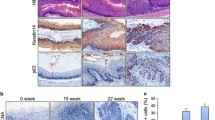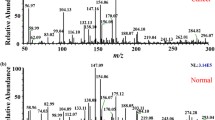Abstract
Recent studies have suggested that cysteine, in addition to glutathione, may play a role in the genesis, pathobiology, and treatment response of rodent and human cancers. We examined the relative concentrations of cysteine and glutathione in human esophageal cancer and adjacent, minimally involved esophageal tissue. Small biopsies from tumors and adjacent esophageal tissues were placed into cold acid to allow extraction of low-molecular-mass compounds and simultaneous precipitation of macromolecules. Supernatants were analyzed by high-performance liquid chromatography with electrochemical detection for thiol content. While there was no statistically significant difference between the glutathione content of tumor versus adjacent tissue (2.2 mM vs 2.1 mM, respectively), tumor tissue had significantly higher levels of cysteine than adjacent tissue (0.21 mM vs 0.13 mM, respectively). In conclusion, cysteine content distinguishes tumor from adjacent more normal tissue.
Similar content being viewed by others
REFERENCES
Warburg OH: Ideen zur fermentchemic der tumoren. Berlin, Academie-Verlag, 1947
Weinhouse S: What are isozymes telling us about gene regulation in cancer? J Natl Cancer Inst 68:343–349, 1982
Evans SM, Hahn S, Pook DR, Jenkins WT, Chalian AA, Zhang P, Stevens C, Weber R, Weinstein G, Benjamin I, Mirza N, Morgan M, Rubin S, McKenna WG, Lord EM, Koch CJ: Detection of hypoxia in human squamous cell carcinoma by EF5 binding. Cancer Res 60:2018–2024, 2000
Fyles AW, Milosevic M, Pintilie M, Syed A, Hill RP: Anemia, hypoxia and transfusion in patients with cervix cancer: a review. Radiother Oncol 57:13–19, 2000
Koong AC, Mehta VK, Le QT, Fisher GA, Terris DJ, Brown JM, Bastidas AJ, Vierra M: Pancreatic tumors show high levels of hypoxia. Int J Radiat Oncol Biol Phys 48:919–922, 2000
Nordsmark M, Overgaard J: Oxygenation of human tumors; the Aarhus experience. In Tumor Hypoxia; Pathophysiology, Clinical Significance, and Therapeutic Perspectives. PV aD Kelleher (ed). Stuttgart, Wissenschaftliche Verlagsgesellschaft, H, 1999, pp 19–28
Brizel DM, Rosner GL, Prosnitz LR, Dewhirst MW: Patterns and variability of tumor oxygenation in human soft tissue sarcomas, cervical carcinomas, and lymph node metastases. Int J Radiat Oncol Biol, Phys 32:1121–1125, 1995
Hockel M, Schlenger K, Hockel S, Vaupel P: Hypoxic cervical cancers with low apoptotic index are highly aggressive. Cancer Res 59:4525–4528, 1999
Hruban RH: Molecular pathology of pancreatic cancer. Cancer Res 61:8830–8837, 2001
Karumanchi SA, Gunningham SP: Vascular endothelial growth factor-B and vascular endothelial growth factor-C expression in renal cell carcinomas: regulation by the von Hippel-Lindau gene and hypoxia. Physiol Genom 5:119–128, 2001
Cairncross JG, Ueki K, Zlatescu MC, Lisle DK, Finkelstein DM, Hammond RR, Silver JS, Stark PC, Macdonald DR, Ino Y, Ramsay DA, Louis DN: Specific genetic predictors of chemotherapeutic response and survival in patients with anaplastic oligodendrogliomas. J Natl Cancer Inst 90:1473–1479, 1998
Mitchell JB: Role of glutathione and other endogenous thiols in radiation protection. Br J Cancer Suppl 8:96–104, 1987
Mitchell JB: The role of glutathione in radiation and drug induced cytotoxicity. Radiat Res 103:232–239, 1985
Biaglow JE, Varnes ME, Clark EP, Epp ER: The role of thiols in cellular response to radiation and drugs. Radiat Res 95:437–455, 1983
Bump EA, Cerce BA, al-Sarraf R, Pierce SM, Koch CJ: Radioprotection of DNA in isolated nuclei by naturally occurring thiols at intermediate oxygen tension. Radiat Res 132:94–104, 1992
Koch CJ, Evans SM: Cysteine concentrations in rodent tumors: unexpectedly high values may cause therapy resistance. Intl J Cancer 67:661–667, 1996
Horan AD: The K(m) for radiosensitization of human tumor cells by oxygen is much greater than 3 mmHg and is further increased by elevated levels of cysteine. J Antimicrob Chemother 48:105–107, 2001
Horan AD, Chan CY, Pletcher CH, Menon C, Evans SM, Moore JS, Koch CJ: Analysis of tumor thiol concentrations: comparison of flow cytometric with chemical and biochemical techniques. Cytometry 29:76–82, 1997
Baker MA: Microtiter plate assay for the measurement of glutathione and glutathione disulfide in large numbers of biological samples. J Pediatr Gastroenterol Nutr 11:247–253, 1990
Tietze F: Enzymic method for quantitative determination of nanogram amounts of total and oxidized glutathione: applications to mammalian blood and other tissues. Anal Biochem 27:502–522, 1969
Tew KD: Glutathione-associated enzymes in anticancer drug resistance. J Urol 155:1395, 1996
Cook JA: Measurement of thiols in cell populations from tumor and normal tissue. Anti-Cancer Drug Design 10:119–129, 1995
Russo A: The roles of intracellular glutathione in antineoplastic chemotherapy. Int J Radiat Oncol Biol Phys 12:1191–1193, 1986
Reed DJ: Glutathione: toxicological implications. Annu Rev of Pharmacol Toxicol 30:603–631, 1990
Koch CJ, Skov KA: Enhanced radiation-sensitivity by preincubation with nitroimidazoles: Effect of glutathione depletion. Int J Radiat Oncol Biol Phys 29:345–349, 1994
Ayene IS, Koch CJ, Krisch RE: Modification of radiation-induced strand breaks by glutathione: comparison of single-and doublestrand breaks in SV40 DNA. Radiat Res 144:1–8, 1995
Jadhav GK, Bhanumathi P, Uma Devi P, Seetharamaiah T, Vidyasagar MS, Rao KK, Hospet CS, Solomon JG: Possible role of glutathione in predicting radiotherapy response of cervix cancer. [erratum appears in Int J Radiat Oncol Biol Phys J;44(3):745, 1999]. Int J Radiat Oncol Biol Phys 41:3–5, 1998
Koch CJ, Stobbe CC, Bump EA: The effect on the K m for radiosensitization at 0 degree C of thiol depletion by diethylmaleate pretreatment: quantitative differences found using the radiation sensitizing agent misonidazole or oxygen. Radiat Res 98:141–153, 1984
Koch C: Measurement of absolute oxygen levels in cells and tissues using oxygen sensors and the 2-nitroimidazole, EF5. In Methods in Enzymology: Antioxidants and Redox Signaling. S A Packer (ed), 2002
Guichard M, Lespinasse F, Estelin R, Gerbaulet A, Haie C, Lartigau E, Malaise EP, Micheau C, Prade M, Richard JM: Glutathione and cysteine levels in human tumour biopsies. Br J Radiol 63:557–561, 1990
Roberts JC: The importance of sample preparation and storage in glutathione analysis. Lancet 359:403–404, 2002
Standeven AM: Tissue-specific changes in glutathione and cysteine after buthionine sulfoximine treatment of rats and the potential for artifacts in thiol levels resulting from tissue preparation. Dis Colon Rectum 36:681–688, 1993
Meister A: Intracellular cysteine and glutathione delivery systems. Proc Natl Acad Sci USA 83:1246–1250, 1986
Vukovic V, Nicklee T, Hedley DW: Microregional heterogeneity of non-protein thiols in cervical carcinomas assessed by combined use of HPLC and fluorescence image analysis. Clin Cancer Res 6:1826–1832, 2000
Vukovic V, Nicklee T, Hedley DW: Differential effects of buthionine sulphoximine in hypoxic and non-hypoxic regions of human cervical carcinoma xenografts. Radiother Oncol 60:69–73, 2001
Mitchell JB, Russo A, Biaglow JE, McPherson S: Cellular glutathione depletion by diethyl maleate or buthionine sulfoximine: no effect of glutathione depletion on the oxygen enhancement ratio. Radiat Res 96:422–428, 1983
Author information
Authors and Affiliations
Rights and permissions
About this article
Cite this article
Evans, S., Lew, R., Kochman, M. et al. Human Esophageal Cancer Is Distinguished from Adjacent Esophageal Tissue by Tissue Cysteine Concentrations. Dig Dis Sci 47, 2743–2750 (2002). https://doi.org/10.1023/A:1021009322843
Issue Date:
DOI: https://doi.org/10.1023/A:1021009322843




